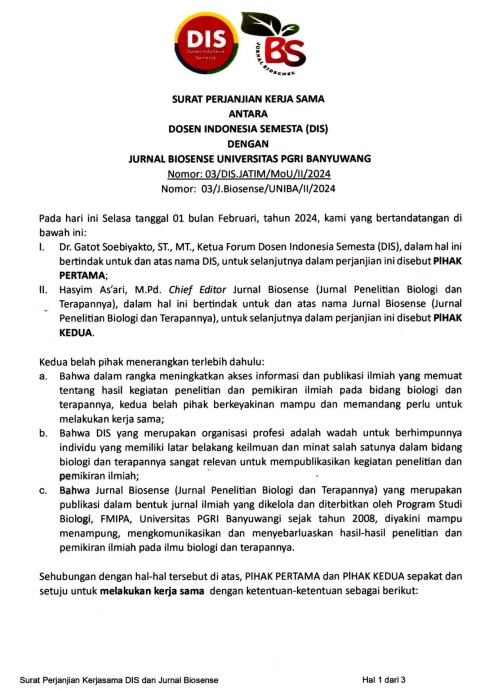PENAMBATAN MOLEKUL SENYAWA VOLATIL EKSTRAK DIKLOROMETANA SAMBILOTO TERHADAP JALUR PENSINYAL EPIDERMAL GROWTH FACTOR RECEPTOR
Penambatan Molekul Senyawa Volatil Ekstrak Diklorometana Sambiloto Terhadap Onkoprotein Human Epidermal Growth Factor Receptor
DOI:
https://doi.org/10.36526/biosense.v5i01.1948Keywords:
Bitter leaves; EGFR, Molecular docking; Volatile compoundsAbstract
EGFR oncoprotein has been commonly studied in combating cell cancer development. However, until this moment the EGFR inhibitors were reported to cause other health issues. Plant extracts are trusted as the potential inhibitor of EGFR expression level without affect our health. We previously observed seventeen volatile compounds in the dichloromethane extract of Andrographis paniculata. Our objective was to analyze the interaction of volatile compounds from the dichloromethane extract of Andrographis paniculata on human EGFR pathway. In silico technique with ligand-receptor molecular docking was used in this study. The structure of volatile compounds was set as the ligands. EGFR, PIK3CA, KRAS-GTP, BRAF V600E, and AKT protein structures were assigned as the receptors. PyRx and Biovia Discovery Studio were used in this docking study. Drug-likeness and lead-likeness properties were appraised by SwissADME and Pre-ADME/Tox web tools. Beta-amyrin and stigmasterol showed the highest binding affinity to EGFR oncoproteins. PIK3CA, AKT, and KRAS-GTP, BRAF V600E was bound to beta-amyrin and stigmasterol, respectively. Those compounds structurally showed drug-likeness and non-mutagenic. Briefly, beta-amyrin and stigmasterol will be potentially used as the inhibitors of selected oncoproteins. In vitro technique and animal model are suggested to be performed to validate the mutagenic mechanisms of beta-amyrin and stigmasterol
References
Atanasov, A. G., Zotchev, S. B., Dirsch, V. M., Orhan, I. E., Banach, M., Rollinger, J. M., … Supuran, C. T. (2021). Natural products in drug discovery: advances and opportunities. Nature Reviews Drug Discovery, 20(3), 200–216. https://doi.org/10.1038/s41573-020-00114-z
Azam, S. S., & Abbasi, S. W. (2013). Molecular docking studies for the identification of novel melatoninergic inhibitors for acetylserotonin-O-methyltransferase using different docking routines. Theoretical Biology and Medical Modelling, 10(1), 1–16. https://doi.org/10.1186/1742-4682-10-63
Bickerton, G. R., Paolini, G. V, Besnard, J., Muresan, S., & Hopkins, A. L. (2012). Quantifying the chemical beauty of drugs Europe PMC Funders Group. Nature Chemistry, 4(2), 90–98. https://doi.org/10.1038/nchem.1243.Quantifying
Chen, Z., Wang, C., Dong, H., Wang, X., Gao, F., Zhang, S., & Zhang, X. (2020). Aspirin has a better effect on PIK3CA mutant colorectal cancer cells by PI3K/Akt/Raptor pathway. Molecular Medicine, 26(1), 1–13. https://doi.org/10.1186/s10020-020-0139-5
Chu, N., Salguero, A. L., Liu, A. Z., Chen, Z., Dempsey, D. R., Ficarro, S. B., … Cole, P. A. (2018). Akt Kinase Activation Mechanisms Revealed Using Protein Semisynthesis. Cell, 174(4), 897-907.e14. https://doi.org/10.1016/j.cell.2018.07.003
Churiyah, Pongtuluran, O. B., Rofaani, E., & Tarwadi. (2015). Antiviral and Immunostimulant Activities of Andrographis paniculata. HAYATI Journal of Biosciences, 22(2), 67–72. https://doi.org/10.4308/hjb.22.2.67
Daina, A., & Zoete, V. (2016). A BOILED-Egg to predict gastrointestinal absorption and brain penetration of small molecules. ChemMedChem, 1117–1121. https://doi.org/10.1002/cmdc.201600182
Doe, J. E., Boobis, A. R., Dellarco, V., Fenner-Crisp, P. A., Moretto, A., Pastoor, T. P., … Wolf, D. C. (2019). Chemical carcinogenicity revisited 2: Current knowledge of carcinogenesis shows that categorization as a carcinogen or non-carcinogen is not scientifically credible. Regulatory Toxicology and Pharmacology, 103(October 2018), 124–129. https://doi.org/10.1016/j.yrtph.2019.01.024
Dolatkhah, R., Somi, M. H., Shabanloei, R., Farassati, F., Fakhari, A., & Dastgiri, S. (2018). Main risk factors association with proto-oncogene mutations in colorectal cancer. Asian Pacific Journal of Cancer Prevention, 19(8), 2183–2190. https://doi.org/10.22034/APJCP.2018.19.8.2183
Egan, W. J., Merz, K. M., & Baldwin, J. J. (2000). Prediction of drug absorption using multivariate statistics. Journal of Medicinal Chemistry, 43(21), 3867–3877. https://doi.org/10.1021/jm000292e
European Commision. (2013). Interpretation of the WSSD 2020 Chemicals. Luxembourg.
Faisal, M., Maungchanburee, S., Dokduang, S., Rattanburee, T., Tedasen, A., & Graidist, A. P. (2021). Dichloromethane crude extract of gymnanthemum extensum combined with low piperine fractional piper nigrum extract induces apoptosis on human breast cancer cells. Indian Journal of Pharmaceutical Sciences, 83(2), 247–260. https://doi.org/10.36468/pharmaceutical-sciences.770
Falzone, L., Salomone, S., & Libra, M. (2018). Evolution of cancer pharmacological treatments at the turn of the third millennium. Frontiers in Pharmacology, 9(NOV). https://doi.org/10.3389/fphar.2018.01300
Ghose, A. K., Viswanadhan, V. N., & Wendoloski, J. J. (1999). A knowledge-based approach in designing combinatorial or medicinal chemistry libraries for drug discovery. 1. A qualitative and quantitative characterization of known drug databases. Journal of Combinatorial Chemistry, 1(1), 55–68. https://doi.org/10.1021/cc9800071
Hamada, T., Nowak, J. A., & Ogino, S. (2017). PIK3CA mutation and colorectal cancer precision medicine. Oncotarget, 8(14), 22305–22306. https://doi.org/10.18632/oncotarget.15278
Honma, M., Kitazawa, A., Kasamatsu, T., & Sugiyama, K. ichi. (2020). Screening for Ames mutagenicity of food flavor chemicals by (quantitative) structure-activity relationship. Genes and Environment, 42(1), 1–6. https://doi.org/10.1186/s41021-020-00171-1
Hunter, J. C., Gurbani, D., Ficarro, S. B., Carrasco, M. A., Lim, S. M., Choi, H. G., … Westover, K. D. (2014). In situ selectivity profiling and crystal structure of SML-8-73-1, an active site inhibitor of oncogenic K-Ras G12C. Proceedings of the National Academy of Sciences of the United States of America, 111(24), 8895–8900. https://doi.org/10.1073/pnas.1404639111
IARC. (2020). The Global Cancer Observatory - All cancers. Retrieved March 14, 2022, from Globocan website: https://gco.iarc.fr/today/home
Jorgensen, A. L., FitzGerald, R. J., Oyee, J., Pirmohamed, M., & Williamson, P. R. (2012). Influence of CYP2C9 and VKORC1 on Patient Response to Warfarin: A Systematic Review and Meta-Analysis. PLoS ONE, 7(8). https://doi.org/10.1371/journal.pone.0044064
Kodchakorn, K., Poovorawan, Y., Suwannakarn, K., & Kongtawelert, P. (2020). Molecular modelling investigation for drugs and nutraceuticals against protease of SARS-CoV-2. Journal of Molecular Graphics and Modelling, 101, 107717. https://doi.org/10.1016/j.jmgm.2020.107717
Kontomanolis, E. N., Koutras, A., Syllaios, A., Schizas, D., Mastoraki, A., Garmpis, N., … Fasoulakis, Z. (2020). Role of oncogenes and tumor-suppressor genes in carcinogenesis: A review. Anticancer Research, 40(11), 6009–6015. https://doi.org/10.21873/anticanres.14622
Kwok, C. S., & Loke, Y. K. (2010). Critical overview on the benefits and harms of aspirin. Pharmaceuticals, 3(5), 1491–1506. https://doi.org/10.3390/ph3051491
Lipinski, C. A., Lombardo, F., Dominy, B. W., & Feeney, P. J. (2001). Experimental and computational approaches to estimate solubility and permeability in drug discovery and development settings. Advanced Drug Delivery Reviews, 46, 3–26. https://doi.org/10.1016/S0169-409X(00)00129-0
Liu, J., Zhou, Q., Xu, J., Wang, J., & Zhang, Y. (2016). Detection of EGFR expression in patients with colorectal cancer and the therapeutic effect of cetuximab. Journal of B.U.ON., 21(1), 95–100.
Luo, C., Xie, P., & Marmorstein, R. (2008). Identification of BRAF inhibitors through in silico screening. Journal of Medical Chemistry, 51(19), 6121–6127. https://doi.org/10.1021/jm800539g
Mandelker, D., Gabelli, S. B., Schmidt-Kittler, O., Zhu, J., Cheong, I., Huang, C. H., … Amzel, L. M. (2009). A frequent kinase domain mutation that changes the interaction between PI3Kα and the membrane. Proceedings of the National Academy of Sciences of the United States of America, 106(40), 16996–17001. https://doi.org/10.1073/pnas.0908444106
Martin, Y. C. (2005). A bioavailability score. Journal of Medicinal Chemistry, 48(9), 3164–3170. https://doi.org/10.1021/jm0492002
Masuda, H., Zhang, D., Bartholomeusz, C., Doihara, H., Hortobagyi, G. N., & Ueno, N. T. (2013). Role of Epidermal Growth Factor Receptor in Breast Cancer. Breast Cancer Res Treat, 136(2). https://doi.org/10.1007/s10549-012-2289-9
Mehner, C., Oberg, A. L., Goergen, K. M., Kalli, K. R., Maurer, M. J., Nassar, A., … Radisky, E. S. (2017). EGFR as a prognostic biomarker and therapeutic target in ovarian cancer: Evaluation of patient cohort and literature review. Genes and Cancer, 8(5–6), 589–599. https://doi.org/10.18632/genesandcancer.142
Muegge, I. (2001). Effect of Ligand Volume Correction on PMF Scoring. Journal of Computational Chemistry, 22(4), 418–425. https://doi.org/10.1002/1096-987X(200103)22:4<418::AID-JCC1012>3.0.CO;2-3
Murugan, N. A., Pandian, C. J., & Jeyakanthan, J. (2021). Computational investigation on Andrographis paniculata phytochemicals to evaluate their potency against SARS-CoV-2 in comparison to known antiviral compounds in drug trials. Journal of Biomolecular Structure and Dynamics, 39(12), 4415–4426. https://doi.org/10.1080/07391102.2020.1777901
Niwa, T., Yanai, M., Matsumoto, M., & Shizuku, M. (2019). Effect of Cytochrome P450 (CYP) 2D6 Genetic Polymorphism on the Inhibitory Action of Antidepressants on CYP2D6-Mediated Dopamine Formation from p-Tyramine. Journal of Pharmacy and Pharmaceutical Sciences, 21(1), 135–142. https://doi.org/10.18433/JPPS29673
Oprea, T. I., Davis, A. M., Teague, S. J., & Leeson, P. D. (2001). Is There a Difference between Leads and Drugs? A Historical Perspective. Journal of Chemical Information and Computer Sciences, 41(3–6), 1308–1315. https://doi.org/10.1021/ci010366a
Pinto, C., Barone, C. A., Girolomoni, G., Russi, E. G., Merlano, M. C., Ferrari, D., & Maiello, E. (2011). Management of skin toxicity associated with cetuximab treatment in combination with chemotherapy or radiotherapy. The Oncologist, 16(2), 228–238. https://doi.org/10.1634/theoncologist.2010-0298
Pinzi, L., & Rastelli, G. (2019). Molecular docking: Shifting paradigms in drug discovery. International Journal of Molecular Sciences, 20(18). https://doi.org/10.3390/ijms20184331
Pires, D. E. V., Blundell, T. L., & Ascher, D. B. (2015). pkCSM: Predicting small-molecule pharmacokinetic and toxicity properties using graph-based signatures. Journal of Medicinal Chemistry, 58(9), 4066–4072. https://doi.org/10.1021/acs.jmedchem.5b00104
Roy, A. (2021). Molecular docking analysis of compounds from Andrographis paniculata with EGFR. Bioinformation, 17(1), 23–28. https://doi.org/10.6026/97320630017023
Sah, S. K., Rasool, U., & Hemalatha, S. (2020). Andrographis paniculata extract inhibit growth, biofilm formation in multidrug resistant strains of Klebsiella pneumoniae. Journal of Traditional and Complementary Medicine, 10(6), 599–604. https://doi.org/10.1016/j.jtcme.2019.02.006
Samuels, Y., & Waldman, T. (2010). Oncogenic Mutations of PIK3CA in Human Cancers Yardena. Curr Top Microbiol Immunology, 347, 21–41. https://doi.org/10.1007/82_2010_68
Santos, G. da C., Shepherd, F. A., & Tsao, M. S. (2011). EGFR Mutations and Lung Cancer. Annu Rev Pathol Mech Dis, 6, 49–69. https://doi.org/10.1146/annurev-pathol-011110-130206
Sharma, A., Vora, J., Patel, D., Sinha, S., Jha, P. C., & Shrivastava, N. (2020). Identification of natural inhibitors against prime targets of SARS-CoV-2 using molecular docking, molecular dynamics simulation and MM-PBSA approaches. Journal of Biomolecular Structure and Dynamics, 0(0), 1–16. https://doi.org/10.1080/07391102.2020.1846624
Sharmila, R., Subburathinam, K. M., Aishwarya, S., & Margret, A. A. (2013). In-Silico Analysis of Andrographolide against Cancer. International Journal of Pharmaceutical Sciences and Drug Research, 5(2), 56–61. Retrieved from www.ijpsdr.com
Teague, S. J., Davis, A. M., Leeson, P. D., & Oprea, T. (1999). The design of leadlike combinatorial libraries. Angewandte Chemie - International Edition, 38(24), 3743–3748. https://doi.org/10.1002/(SICI)1521-3773(19991216)38:24<3743::AID-ANIE3743>3.0.CO;2-U
Veber, D. F., Johnson, S. R., Cheng, H. Y., Smith, B. R., Ward, K. W., & Kopple, K. D. (2002). Molecular properties that influence the oral bioavailability of drug candidates. Journal of Medicinal Chemistry, 45(12), 2615–2623. https://doi.org/10.1021/jm020017n
Vélez-Cruz, R., & Johnson, D. G. (2017). The retinoblastoma (RB) tumor suppressor: Pushing back against genome instability on multiple fronts. International Journal of Molecular Sciences, 18(8). https://doi.org/10.3390/ijms18081776
Wang, A., Li, X., Wu, H., Zou, F., Yan, X. E., Chen, C., … Liu, Q. (2017). Discovery of (R)-1-(3-(4-Amino-3-(3-chloro-4-(pyridin-2-ylmethoxy)phenyl)-1H-pyrazolo[3,4-d]pyrimidin-1-yl)piperidin-1-yl)prop-2-en-1-one (CHMFL-EGFR-202) as a Novel Irreversible EGFR Mutant Kinase Inhibitor with a Distinct Binding Mode. Journal of Medicinal Chemistry, 60(7), 2944–2962. https://doi.org/10.1021/acs.jmedchem.6b01907
Wu, W. K. K., Wang, X. J., Cheng, A. S. L., Luo, M. X. M., Ng, S. S. M., To, K. F., … Yu, J. (2013). Dysregulation and crosstalk of cellular signaling pathways in colon carcinogenesis. Critical Reviews in Oncology/Hematology, 86(3), 251–277. https://doi.org/10.1016/j.critrevonc.2012.11.009
Zhang, C., Spevak, W., Zhang, Y., Burton, E. A., Ma, Y., Habets, G., … Bollag, G. (2015). RAF inhibitors that evade paradoxical MAPK pathway activation. Nature, 526(7574), 583–586. https://doi.org/10.1038/nature14982

















